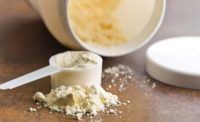At this year’s IFT Food Expo, many companies were demonstrating products with novel proteins, including plant and insect proteins.
Tasting is believing and so I tasted liberally. Many of these novel proteins worked well in savory applications, but imparted unfamiliar and unpleasant notes to beverages and traditional dairy products such as yogurt. Their protein quality also scores significantly below that of dairy proteins. But interesting work is underway to improve both flavor and quality of novel proteins.
Insects and other sources
Experts agree that new protein sources will have to be developed to meet the needs of earth’s anticipated 9 billion inhabitants by 2050. Novel protein ingredients abound, including those from pulses, hemp, algae and flax. RuBisCo, the main protein in green plants and the most abundant protein on earth, can now be extracted as a protein ingredient for the food market. Mealworms and crickets are being commercialized as food ingredients.
Interestingly, many novel proteins are actually quite old. Insects are consumed as supplementary food by some communities around the world and have been used since ancient times. Seaweed, bark and grass have also been consumed, mostly in time of famine. But the actual nutritional quality of some of these proteins is unknown. Many of these foods are actually quite rich in anti-nutrients (phytates in soy for example), or need extensive processing to remove those components. These anti-nutrients may also further impair absorption of other nutrients such as minerals.
“Severe levels of undernutrition and high incidences of stunted growth can be seen in the populations who only have access to low-quality protein sources,” said Veronique LaGrange, senior vice president of strategy and insights for the U.S. Dairy Export Council.
Quality matters
In order to understand the nutritional value of novel proteins, we must first accurately measure their amino acid content and their true digestibility. In 2013, the FAO published a new quality method, DIAAS to replace PDCAAS. The new method uses ileal rather than fecal digestibility to more accurately determine the nutritional value of proteins in the human diet. Measuring ileal digestibility is more costly and adoption of the new method has been slow.
Unfortunately for the dairy industry, the final regulations for the revision of the U.S. nutrition and supplement facts labels did not adopt DIAAS. The Food and Drug Administration stated, “We agree that the DIAAS is an important new method of evaluating protein quality when true ileal amino acid digestibility data are used. However, we decline to replace the PDCAAS with DIAAS in the final rule because there are insufficient data available to implement the DIAAS.”
“In the short term, we are working with industry partners to collect the digestibility data needed to implement DIAAS and look forward to information about the cost savings and accuracy of physiological digestion models,” said Cindy Schweitzer, technical director, Global Dairy Platform.
As data become more robust, product developers will be able to use computer programs to optimize combinations of plant and dairy proteins to match target nutritional profiles.
Processing improvements
Beyond nutrition, functional attributes of plant proteins will need to be improved if they are to supplement or compete with dairy proteins. Major stumbling blocks for plant proteins include solubility issues and oxidation-derived off-flavor notes.
“Mild extraction processing techniques can create proteins that do not precipitate and aggregate, thus opening up new application opportunities for novel proteins in beverage applications,” said Rene Floris, division manager of flavor and texture for NIZO. “Our flavor work has focused on removing volatile organic compounds from plant proteins. We have explored combinations of plant proteins and ways that plant proteins, including pea, lentil, pulses and insects, can complement or complete dairy proteins. Understanding design rules will help dairy companies to optimize cost, nutrition and flavor in novel protein-fortified beverages.”
New dairy farmer-funded research compared milk and fortified milk to a variety of plant-based beverages.
“Manufacturing alternative beverages requires additional processing steps that aren’t needed to process milk. These processing steps include chemical extractions and blending in additives, such as sugars, oils, gums and nutrients. When we compared the cost of alternative beverages, we found that almond beverage protein is 18 times more expensive per gram than fluid milk protein,” said Siva Kaliapan, vice-president product research at Dairy Management Inc.
Dairy’s appeal includes great taste, high-quality protein and a clean label. But the dairy industry should expect stiff competition as plant proteins evolve.




